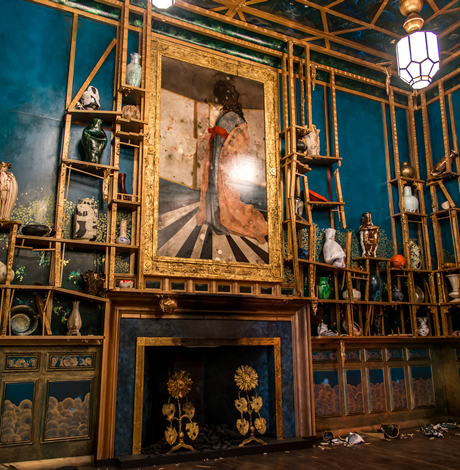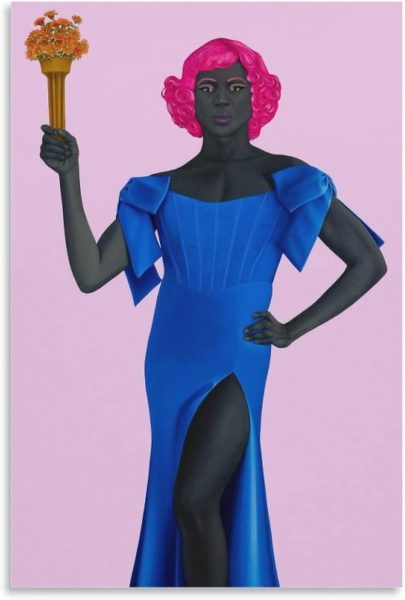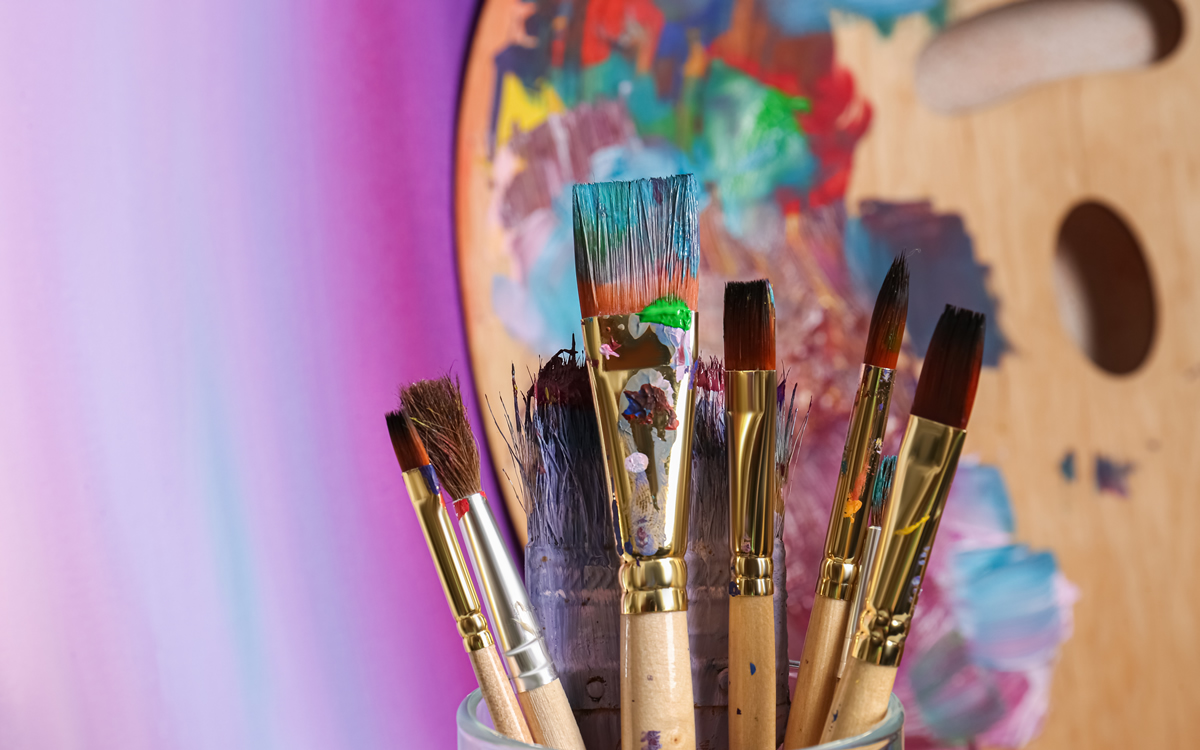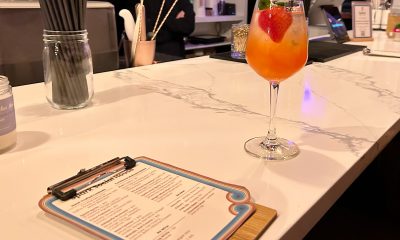Galleries
A ‘Filthy’ remix
Gay artist’s ‘Peacock Room’ re-imagines a classic


‘Filthy Lucre’ is a contemporary take on the acclaimed ‘Peacock Room’ by 19th century American artist James McNeill Whistler. (Photo by Hutomo Wicaksono)
Hearing a remixed version of a song on the radio or in the club can be both jarring and familiar at the same. Gay contemporary artist Darren Waterston has taken that “I’ve heard this before” feeling from an auditory sense to a visual experience with his new art piece “Peacock Room REMIX: Darren Waterston’s Filthy Lucre” located in the Freer and Sackler Galleries of Art (1050 Independence Ave., S.W.).
“Filthy Lucre” is a contemporary take on the acclaimed “Peacock Room” by 19th century American artist James McNeill Whistler that is on permanent display in the Freer and Sackler Galleries of Art. Waterston’s reimagining of the room depicts how Waterston views the original “Peacock Room” in context with the room’s tragic history. The exhibit opens Saturday and will remain open through January 2017.
“When I walked into the ‘Peacock Room’ for the first time I was struck by how extraordinarily beautiful it was,” Waterston says. “There’s something about the ‘Peacock Room’ that had this sense of decadence that was so beautiful and excessive that it almost becomes grotesque.”
That feeling is very much attached to the room’s history. Whistler was asked by his friend and patron Frederick Richards Leyland for a color scheme in Leyland’s recently redecorated dining room in South Kensington, England. While Leyland was away on a trip, Whistler completely repainted the room without consulting Leyland. Leyland was outraged and refused to pay Whistler for his work. Their feud lasted for the rest of their lives.
Waterston found himself connecting with Whistler’s hardships in finding recognition for his work at the beginning of a gilded age in art as well as the issues between money and art. They are themes that Waterston believes are still relevant in today’s world of art.
“You have this incredible collision of enormous wealth that has been dissimilated and extraordinary deprivation and hardship,” Waterston says. “We are living in our own gilded age.”
He began creating the piece while doing a yearlong residency at Massachusetts Museum of Contemporary Art. He decided to reach out to Lee Glazer, Associate Curator of American Art at Freer and Sackler Galleries of Art. Her mentorship over the project resulted in her inviting Waterston to display the work alongside the original “Peacock Room” in the gallery.
Alternative rock group and LGBT activists BETTY created the background music that plays when entering “Filthy Lucre.” Waterston says that he had known the group for years and reached out to them to collaborate on the project. He says that the music came together before he had even started to build the room.
“They composed a huge, beautiful symphonic piece called ‘Filthy Lucre’ and then not unlike how the room was built, we dissembled it, broke it, fractured it so that the sound scape is actually fragments and shards of the original piece,” Waterston says.
“Filthy Lucre” appears to also be fragments of the original ‘Peacock Room.” “Peacock Room” is an elaborately decorated blue and gold creation while “Filthy Lucre” appears to be a deconstructed and worn down version of the same room. Glazer says that she didn’t even realize the two pieces would be complementing each other in such a way until after it was completed.
“It is very much a commentary of what might have happened to the Peacock Room if it had remained a room inhabited by people and had not been elevated to iconic masterpiece status,” Glazer says.
Waterston wants to bring forward the idea of beauty in masterpieces with “Filthy Lucre” and have people reexamine their initial thoughts on the idea.
“The room itself kind of demands this scrutiny of looking at our own relationship with beauty and our sort of longings and desires that we come to when we come to a work of art that is noted for its extraordinary beauty,” Waterston says. “I wanted to create a sort of upheaval in that and to understand how beauty is a very unstable idea and a very unstable concept.”
Galleries
Blockbuster Amy Sherald exhibit opens in Baltimore
Artist has emerged as LGBTQ hero after refusing to cave to censorship

Artist Amy Sherald has emerged as a hero in the LGBTQ community following her controversial decision to pull her blockbuster new exhibit “American Sublime” from the National Portrait Gallery in D.C. and move it to Baltimore after Smithsonian officials sought to censor her painting “Trans Forming Liberty.”
That painting depicts transgender model Arewà Basit as the Statue of Liberty, which conflicts with President Trump’s war on DEI and his efforts to erase transgender people from the American narrative.
Sherald issued a statement over the summer that the Smithsonian had “concerns” about the painting. “These concerns led to discussions about removing the work from the exhibition,” Sherald said in the statement. “While no single person is to blame, it is clear that institutional fear shaped by a broader climate of political hostility toward trans lives played a role.”
She said the Smithsonian had proposed including a video in the exhibit that would “contextualize” the painting and likely include anti-trans views. It was then she announced her decision to pull the exhibit entirely and move it to the Baltimore Museum of Art, a major coup for the museum.

Sherald studied at Baltimore’s Maryland Institute College of Art, which she described as “the best decision I ever made,” during a sold out Q&A on Nov. 2 moderated by the BMA’s director, Asma Naeem. Unfortunately, the subject of censorship and the last-minute decision to move the exhibit to the BMA didn’t come up during the discussion. But Naeem rightly described Sherald as “one of the most important painters of our time.”
“American Sublime,” billed as a mid-career retrospective, features 38 of Sherald’s paintings, including her portraits of former first lady Michelle Obama and Breonna Taylor, along with “Trans Forming Liberty.”
Sherald and Naeem joked throughout the breezy hour-long conversation and reminisced about spending time at MICA and in Baltimore. The artist said she still finds inspiration and even potential portrait subjects in grocery stores and on the streets of Baltimore and New York, where she now lives. Many of the portraits in the exhibit were painted in Baltimore.
Although Sherald and Naeem kept it light and avoided discussing censorship, the one serious and non-negotiable subject Sherald addressed was the paramount importance of integrity. Her insistence on the integrity of the work and the inclusion of trans representation in the exhibit brought her to the difficult decision to pull her work from the Smithsonian. It was a bold and inspiring move in a time when so many public figures, CEOs, and politicians have shown a disappointing and dangerous lack of integrity in the face of an administration that seeks to subvert the Constitution and erode the First Amendment. Sherald stands as a powerful symbol of resistance and, yes, integrity in these dark times. Her refusal to cave to authoritarian impulses and blatant censorship will be remembered for years to come. The nation’s top tech CEOs and congressional leaders should see this exhibit and learn from her brave example.
“American Sublime” is open now through April 5 at the Baltimore Museum of Art and requires a paid ticket for entry. (Admission is free on Thursday evenings and free on Jan. 15 and Feb. 19. The museum is closed Mondays and Tuesdays.) For more information and tickets visit artbma.org.
Galleries
New gallery opening in D.C.
Dandelion Collective exhibition features works by John Von Sauerhoff

Dandelion Collective, a new space in Columbia Heights for LGBTQ healers and artists, will open on Saturday, Aug. 24 with an opening reception at 2 p.m. at 3417 14th St., N.W.
This first exhibition features the incredible, ethereal artwork of John Von Sauerhoff. His stunning pop surrealist paintings will transport you to another world.
More information is available at dandelioncollectivedc.com/art-gallery.

New England artists Caroline Rufo and John Rufo, also known as RufoArt will open an exhibition on Thursday, Aug. 10 at 6 p.m. at Nepenthe Gallery.
The husband-and-wife duo will share their paintings and also talk about their inspirations. Caroline explores the natural beauty, ideas, and systems of power that create her surroundings while John works toward an understanding of art as a representation of singular moments of both immediate presence and a larger context of wholeness.
For more details, visit Nepenthe Gallery’s website.
-

 U.S. Supreme Court4 days ago
U.S. Supreme Court4 days agoSupreme Court rejects Kim Davis’s effort to overturn landmark marriage ruling
-

 District of Columbia4 days ago
District of Columbia4 days agoCapital Pride files anti-stalking complaint against local LGBTQ activist
-

 Politics1 day ago
Politics1 day agoPro-trans candidates triumph despite millions in transphobic ads
-

 Dining4 days ago
Dining4 days agoSpark Social House to start serving alcohol



















